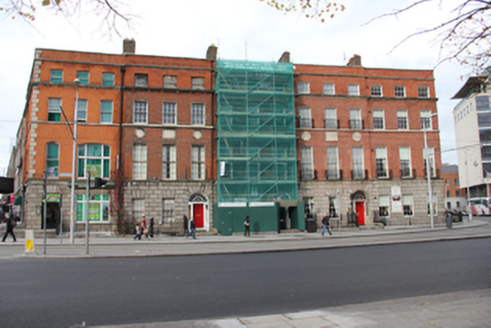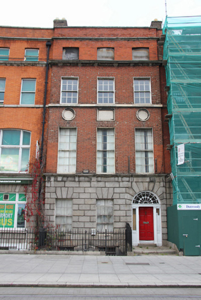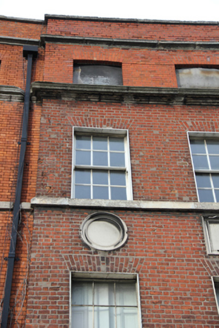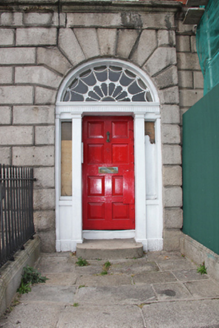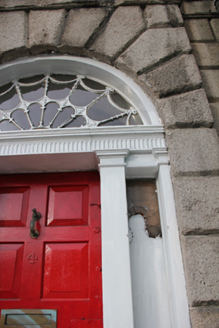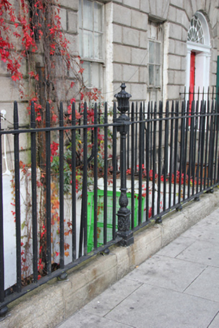Survey Data
Reg No
50010296
Rating
Regional
Categories of Special Interest
Architectural, Artistic, Historical
Original Use
House
Date
1790 - 1795
Coordinates
316367, 234673
Date Recorded
16/10/2011
Date Updated
--/--/--
Description
Terraced three-bay four-storey house over raised basement, built c.1793, as part of crescent of five similar houses to designs of James Gandon. Currently vacant. Double-pile slate roof, rear pile replaced c.1930, hipped to east. Yellow brick chimneystacks with clay pots to both party walls. Roof hidden behind rebuilt parapet wall with granite coping and moulded granite string course to base. Slightly advanced front elevation built in red brick laid in Flemish bond, rebuilt in machine-made red brick to third floor. Deep moulded granite cornice to third floor sill level, plain granite sill course to second floor and rusticated coursed granite walls to ground with plain frieze and moulded cornice to first floor sill level. Cement rendered basement walls with round and rectangular Portland stone blind panels above first floor windows. Gauged brick flat-arch window openings with patent rendered reveals to first and second floors, camber-headed to third floor with voussoired granite heads to ground floor. Boarded up windows to third floor, replacement six-over-six pane timber sliding sash windows to ground and second floors, replacement nine-over-nine pane timber sliding sash to first floor, and two-over-two pane to basement with wrought-iron grilles. Voussoired round-headed door opening with painted stone tripartite doorcase. Replacement timber panelled door flanked by slender pilasters, sidelights and responding corner pilasters supporting fluted lintel cornice and original webbed leaded fanlight over. Door opens onto concrete step and granite platform and two granite steps. Platform and basement area enclosed by iron railings and cast-iron corner posts set on moulded granite plinth wall with matching iron gate, basement access removed. Black and red clay tiles to basement area.
Appraisal
This townhouse was built as part of a crescent of five similar houses for John Beresford, designed by James Gandon and approved by the Wide Street Commissioners in 1792. Now in a semi-derelict condition the house has had some replacement fabric with the loss of some important features, such as a balustraded parapet (repeated to No.2), but retains much of its original character. The crescent was intended to be one of several to encircle Gandon’s Custom House, but the project was never fully realized. Nonetheless, this house and crescent remain the only example of Gandon’s domestic work and involvement in urban design and now forms part of a varied range of architectural styles on Beresford Place. The high quality of the channelled granite ground floor and the cut-stone string courses distinguish this house and the crescent from the generality of early houses in the district. The contrast between granite and brick is very pleasant, and the carved roundels and panel at mid-facade adds further classical architectural interest.
